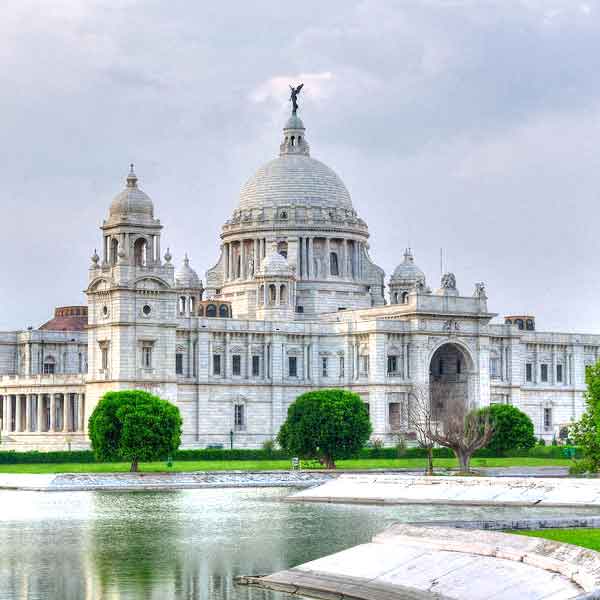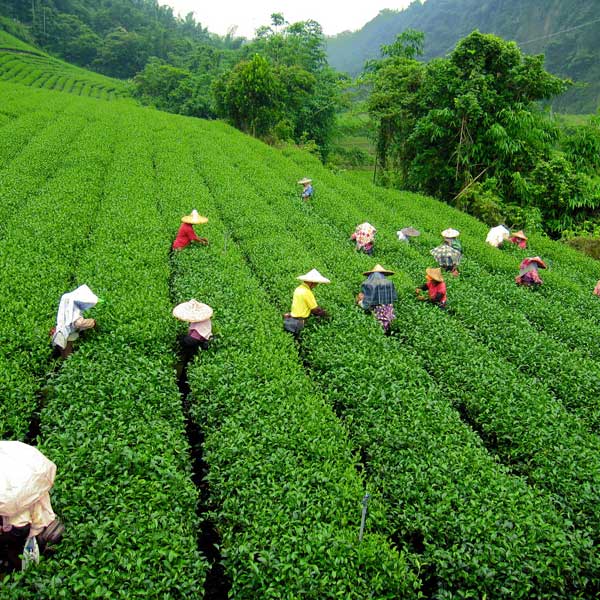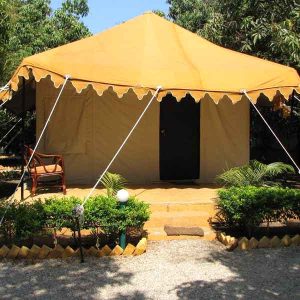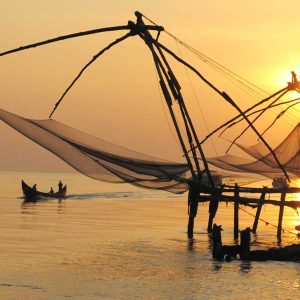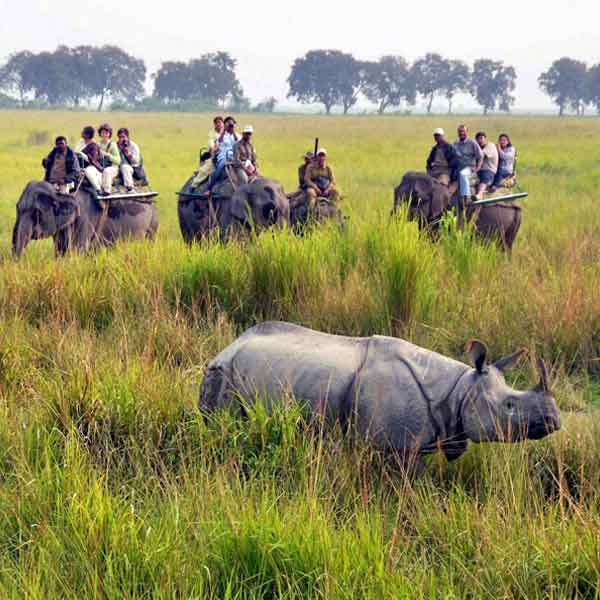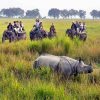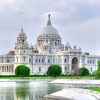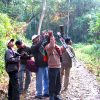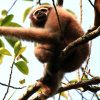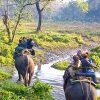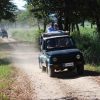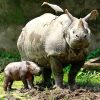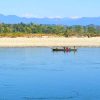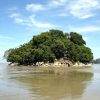Day 01: Arrive in Kolkata (Calcutta).
Arriving in Kolkata this morning, we will transfer to a city hotel where the rest of the day will be spent at leisure. You will be free to sample some of the many delights of Kolkata, or to just relax and recover after your flight. Your leader will help you to arrange any sightseeing you may choose to do; perhaps a visit to one of the famous sights of Kolkata such as the Victoria Memorial or St Paul’s Cathedral, or to one of the excellent museums. We will overnight in Kolkata prior to our flight to Jorhat tomorrow morning.
Day 02: Fly to Jorhat & Begin Brahmaputra Cruise.
After a leisurely breakfast we will transfer to Kolkata airport for the flight to Jorhat, in the state of Assam, where we are scheduled to arrive in the afternoon. This is a wonderful flight, for our flight-path runs parallel to the Great Himalaya and we can expect to enjoy fine views of the peaks of the eastern Himalaya… as long as the weather is clear! On arrival at Jorhat Airport, we will meet our vehicle and driver and drive for 30 minutes to board our ship, the RV Sukapha or RV Charaidew, at Neamati Ghat on the Brahmaputra River.
Day 03: Brahmaputra Cruise: Mariani & Majuli Island.
This morning we will leave our vessel and drive to the Gibbon Sanctuary at Mariani. Here we will walk through the forest in the company of a local forest guard in search of Hoolock Gibbons, India’s only species of ape, as well as a wealth of birdlife. On our return to the ship we will set off down the river, cruising for about an hour or so across to Majuli Island, supposedly the world’s largest river island. Here there are very few cars and little development and the island offers excellent birdwatching, especially at Sakuli Jheel which gives us a fine introduction to Assam’s wetland birds.
Day 04: Brahmaputra Cruise: Majuli Island.
Today we will focus on the rich cultural heritage of Majuli Island, for it possesses unique Hindu monasteries famous for their dance-drama performances. Indeed the whole island has now been short-listed for future UNESCO World Heritage status. We will visit Auniati Monastery with its eclectic museum, enjoy a typical Mising tribal lunch in a stilted bamboo hut and, in the afternoon, we will attend a dance performance at Kamalabari Monastery. For those lacking a ‘cultural leaning’, there will be further opportunities for birdwatching on the island, and from the ship, today. Later we will return to the ship and spend a couple of hours cruising downstream as the sun sets and lines of waterbirds stream back to their night-time roosts.
Day 05: Brahmaputra Cruise: Jamuguri Village.
We will spend much of the day on the river today, watching waterbirds and for otters and Gangetic River Dolphins, not to mention the fascinating activities and techniques of the local fishermen. Our one riverside stop will be at the tribal village of Jamuguri, where we will make an interesting visit.
By the afternoon, Kaziranga National Park will be on our left, and wild Asian Elephants and other mammals such as Hog Deer and wild Water Buffalo may sometimes be seen from the boat. Even the magnificent Tiger has once, memorably, been seen in this way! The evening, as the sun sets on the river and when a beer is safely at hand, will be the ideal time to meticulously scan the river banks and islands for mammals and birds.
Day 06: Brahmaputra Cruise: Kaziranga National Park.
In the early morning, we will take a jeep ride through the park’s little-visited Eastern Range, where good woodland and grassland, and the wildlife they support, can be viewed from look-out towers.
Kaziranga protects an area of 430 square kilometres and is one of the world’s most beautiful national parks. It lies on the south bank of the great Brahmaputra River and is one of the last haunts of the Great Indian One-horned Rhinoceros. The area was first given protection as a forest reserve in the early years of the twentieth century, but it was not opened to visitors until 1938, and it was not until 1954 that the Great Indian One-horned Rhinoceros was given complete statutory protection, allowing Kaziranga to become the most important – and one of the final – refuges for this endangered mammal. In 1974 the wildlife sanctuary was given national park status, and today there are over 1,100 rhinos in the park, a figure which represents over 70% of the world population. The extensive areas of tall elephant grass mean that sightings of Tigers are few, and less frequent than in Kanha and Bandhavgarh; however, in addition to the rhinos, we can expect to see Kaziranga’s important population of wild Water Buffalo (one of the last remaining wild populations), wild Asian Elephants, Wild Boar, Hog Deer, Swamp Deer, Sambar, Barking Deer, Rhesus Macaques and a wide variety of other mammal species. We will also make every effort to locate the other more elusive inhabitants of the park such as Gaur, Leopard, Leopard Cat and Sloth Bear.
Kaziranga’s birdlife is equally diverse and includes an exceptional range of waterbirds (amongst them many species of cormorants, herons, egrets, storks, geese, ducks, waders and terns), birds of prey, and such regional specialities as Swamp Partridge, Bengal Florican, Abbott’s Babbler, Sultan Tit, Black-breasted Thrush, Bristled Grass Warbler, Scarlet-backed Flowerpecker and Little Spiderhunter. It really is a wonderful place to visit.
This afternoon we will continue our voyage down to a delightful mooring at Silghat, where butterflies abound in the surrounding jungle. Close by, where the Bharali River flows into the Brahmaputra, is a favourite feeding spot for the endangered Gangetic River Dolphins (although these can be seen anywhere on the river, and throughout the length of our river journey). At Silghat we will moor and next day enjoy our safari in central range of the Kaziranga National Park.
Day 07: Brahmaputra Cruise: Kaziranga National Park.
We will rise very early this morning and disembark before dawn in order to drive to Kaziranga’s Central Range for an early morning elephant ride, the best way to get really close to the rhinos and all of Kaziranga’s other mammals. Later in the morning, after our breakfast in a beautiful lodge, we will return to Kaziranga’s Central Range for a morning jeep safari before returning to the boat.
In the afternoon, after our lunch, we will walk through terraced tea gardens and visit Durga Temple in a beautiful village before returning to the boat.
Day 08: Brahmaputra Cruise: Kaziranga National Park.
In the morning, we will take a jeep ride through the park’s Western Range, where good woodland, as well as grassland and wetlands, and the wildlife they support, can be viewed from look-out towers. Later we will return to the ship and start cruising downstream to Tezpur as the sun sets and lines of waterbirds stream back to their night-time roosts.
Day 09: Brahmaputra Cruise: Nameri National Park.
Again we will disembark very early today, and drive north to Nameri National Park, which lies in the foothills of the eastern Himalaya an hour’s drive north of Tezpur.
Nameri was given ‘wildlife sanctuary’ status in 1985, before becoming a national park in 1998. It spans 212 square kilometres and its north-eastern boundary adjoins Pakhui Wildlife Sanctuary in the neighbouring state of Arunachal Pradesh. Together they protect over 1,000 square kilometres of tropical evergreen, semi-evergreen, and moist deciduous forests with bamboo and cane brakes, and narrow strips of grassland along the Bharali River (which runs through the park) and its many tributaries. This is excellent elephant country, and the park may hold in excess of 200 Asian Elephants. However, it is Wild Boar, Sambar, Hog and Barking Deer, Rhesus and Assamese Macaques, Capped Langur and Malayan Giant Squirrel that are amongst the common mammals most likely to be seen. Such other mammals as Gaur, Sloth Bear and Himalayan Black Bear, Dhole, Leopard and Tiger require exceptional luck!
The park is a haven for birds, over 315 species having been recorded. A healthy population of the rarely seen Ibisbill is perhaps the highlight, along with a large population of three hornbill species – Great, Oriental Pied and Wreathed Hornbill. Blue-bearded Bee-eaters and a wide range of babbler species may also be along the Bharali River. We will enjoy a walk around the eco camp to look for birds and mammals, then later board inflatable dinghies for around three hours float trip down the Bharali River through the park. In the afternoon, we must return by road to Tezpur where our ship will be waiting and spend four hours cruising down river past Singri Hill to Orang National Park.
Day 10: Brahmaputra Cruise: Orang National Park.
In the morning we will transfer onto a smaller vessel in order to cruise up a side stream into the heart of Orang National Park where we will disembark and take a jeep safari through the park.
Orang, like Nameri, was given ‘wildlife sanctuary’ status in 1985, before becoming a national park in 1999. It spans 78 square kilometres and lies along the north bank of the Brahmaputra River. Known as ‘Mini Kaziranga’, it is a low-lying reserve that protects similar habitats to Kaziranga, notably seasonally-inundated swamps and river islands interspersed with broad tracts of tall elephant grass, open forest, watercourses (known as Jheels) and reedbeds. The park holds a reasonable population of Greater Indian One-horned Rhinoceros, whilst other mammals include Asian Elephants, Sambar, Hog and Barking Deer, and small numbers of Tigers (seen very occasionally by our groups here) and Leopards.
The park is an exceptional haven for waterbirds, with winter visitors and migratory species prominent, especially at the time of our visits. Such specialities as Spot-billed Pelican, Black-necked Stork, Greater and Lesser Adjutant, and Pallas’s Fishing Eagle may all be seen here and, with luck, we may also see the rare and elusive Bengal Florican of which the park holds 30-40. In the afternoon we board our smaller vessel once again and cruise back to our ship, the RV Sukapha or the RV Charaidew and start cruising downstream to Ganesh Pahar.
Day 11: Brahmaputra Cruise: Ganesh Pahar, Peacock Island & Guwahati.
This morning we will take our country boat down towards a range of jungle-covered hills and stop at the idyllic, isolated and roadless, village of Ganesh Pahar, just at their edge. Here we will spend the day walking and birdwatching in the rice paddies and in the unspoilt forest of the hills. This afternoon’s voyage is particularly pretty, with jungle-covered hills lining the south bank. We should reach Guwahati around in the afternoon, leaving us time to visit Peacock Island (with its population of Golden Langur monkeys) and then to land on the main river-front for a visit into town where, for the keen birders in the party, the rubbish dump has its attractions in the form of visiting Greater Adjutant Storks, one of the subcontinent’s most endangered bird species. If time does not permit, then we will visit Peacock Island next day in the morning before visiting Kamakhya Temple. We will return to our ship for our final night aboard.
Day 12: End Brahmaputra Cruise; Fly Kolkata.
This morning we will pay a visit to Nilachal Hill, high above Guwahati, where a good selection of birds may be found in the woodland surrounding the Kamakhya Temple. We must later disembark and transfer to Guwahati airport for our flight to Kolkata, arriving in the evening. On arrival we will be transferred to a city hotel, where we spend the night.
Day 13: Depart Kolkata.
We depart our hotel early in the morning to catch our flight to onward destination.
Please note that the itinerary outlined above is strictly subject to river conditions and daylight hours, which change continually. It offers our planned programme of excursions. However, adverse conditions or weather or other local considerations may necessitate some re-ordering of the programme during the course of the cruise. Any such changes will always be done to maximise the best use of time and weather conditions available. Guests willing to undertake this tour are advised to check with us the precise dates on which this journey can be undertaken.

